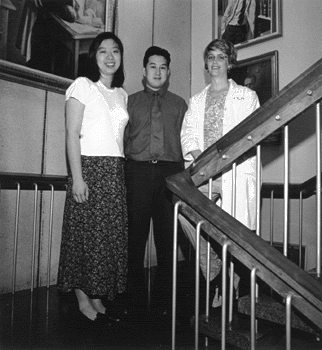|
|
'Chrysalis' Chronicles Medical School JourneyBy Greg RienziThe Gazette |

Transformation can be an uncomfortable phenomenon. Why, just ask the butterfly. When a butterfly enters its pupa stage, it has neither eyes, legs or antennae and cannot move. Essentially, it is nothing more than a blank canvas, with only the potential to become a work of art. But then nature's magic begins. For the next several hours of its existence, all the major changes in the insect's body shape, size and arrangement occur. The entire time it remains trapped inside a tight and constraining translucent sheath called a chrysalis. At the end of the drama, an adult butterfly will awkwardly emerge, its wings small and shriveled but destined for flight.
Melissa Sparrow, a first-year resident in pediatrics, says the life of a medical student is also an uncomfortable and transforming experience. The amount of knowledge needed to be learned is vast, the competition is intense, and all the while doubts and fears scour the terrain like land mines.
"I see medical school as the tight and structured chrysalis that contains us as we transform," Sparrow says.
 Chrysalis: A Journal on Becoming a Physician is,
not coincidentally, the name of an online journal created by
medical students that seeks to document the metamorphosis of
students into physicians. The journal, which debuted in September
1999, contains research papers, essays, poetry, photography,
videos and original artwork created by students at the School of
Medicine.
Chrysalis: A Journal on Becoming a Physician is,
not coincidentally, the name of an online journal created by
medical students that seeks to document the metamorphosis of
students into physicians. The journal, which debuted in September
1999, contains research papers, essays, poetry, photography,
videos and original artwork created by students at the School of
Medicine.
Sparrow, one of the journal's founders and its first editor, says that such a publication was needed to chronicle the emotional aspects of the medical education experience, both the triumphs and the failures. A print version of a similar student-created journal, The Quill and Scalpel, existed between 1990 and 1993.
"We wanted to create a voice speaking to the emotions of medical students as they go through their journey of becoming physicians," Sparrow says. "As medical students and physicians, we often ignore our emotions and put them away. But I feel that makes us less able to be good doctors and interact with patients. We need to both confront our emotions and understand them."
 |
| Amy Ho, editor of the next edition of 'Chrysalis'; Charles Tuchinda, website software engineer; and co-founder Melissa Sparrow, first editor. |
Chrysalis is closely tied to the four-year Physician and Society course, which addresses the history of medicine, health care delivery, medical ethics, cultural determinants of health and illness, doctor-patient communication, the economics of health care, and health policy. Similarly, Chrysalis contains sections on history of medicine, culture and medicine, ethics and medicine, and medical economics. A majority of the articles in the inaugural edition began as course writing assignments.
Jean Ogborn, coordinator of the first-year program of Physician and Society and faculty adviser to Chrysalis, says she had long searched for a place to publish some of the "wonderful" writing that came out of the course.
"I was so impressed with [what] I was reading," says Ogborn, assistant professor in the Department of Pediatrics-Emergency Medicine at the School of Medicine. "But before Chrysalis, there wasn't a way to share these excellent works with the rest of the students and a larger audience."
The first edition, currently online, contains articles on the history of polio, the discrepancy between the United States and Haiti in children's health care and the question of health care as a basic right.
The journal also is intended to provide a forum for the creativity and imagination of Hopkins' doctors-to-be, who, because of the many demands on them, Sparrow says, often repress their artistic side.
A section called "Expressions" exhibits such creations as poetry, short fiction, art, music and digital movies.
"To me, the most exciting aspect of the journal was the art and the poetry and the kind of personal writing that emerged. Some of it was hard to find, but we found these gems," Sparrow says. "There is an enormous source of creativity in the students here, but unfortunately it is sort of hidden. I see one goal of the journal is to somehow unearth these treasures."
Sparrow says the decision to put the journal solely online was due to financial and time constraints and the Internet's ability to disseminate the content on a larger scale.
Technical support and mentoring for the Chrysalis website was provided by the Office of Medical Informatics Education at the School of Medicine. The software used to create the online journal was originally funded through a seed grant provided by the Provost's Office.
The next issue of Chrysalis is due sometime in the fall. Amy Ho, Chrysalis' current editor and a fourth-year medical student, says that one significant addition will be a new section called "The Clinical Years," which will contain essays detailing the experiences of students in the hospital.
Ho, who served as associate editor of the inaugural edition, says that putting this journal together is a time-consuming but extremely rewarding experience.
"I would do it all again without hesitation," Ho says. "I originally got involved with Chrysalis because I have spent so much of my time here studying science that I felt the creative side of me was not being developed, or used at all. This was something I wanted and needed to do to get back in touch with that side of me."
Chrysalis: A Journal on Becoming a Physician is available at http://omie.med.jhmi.edu/chrysalis.
| GO TO MAY 8, 2000 TABLE OF CONTENTS. |
| GO TO THE GAZETTE HOMEPAGE. |